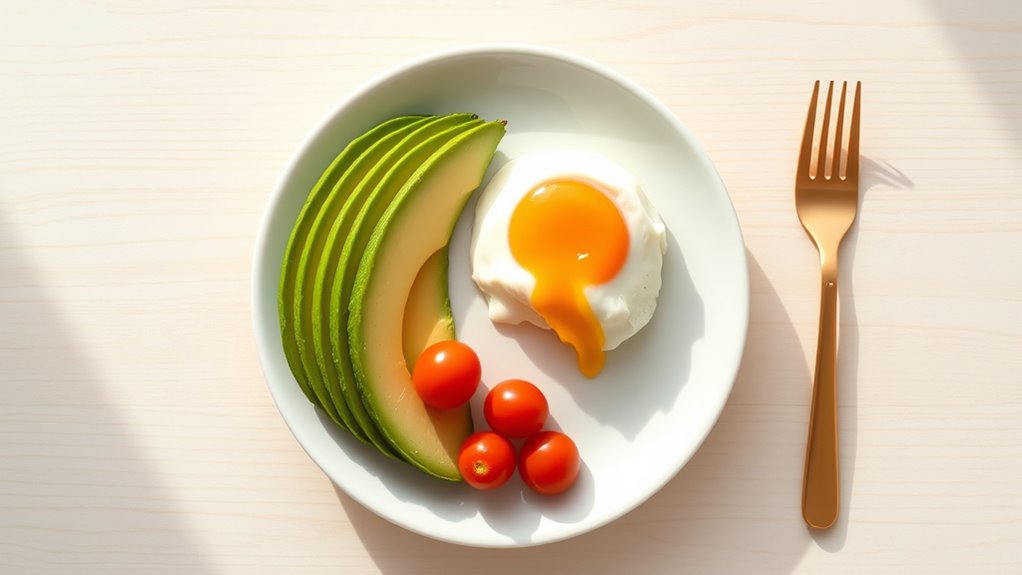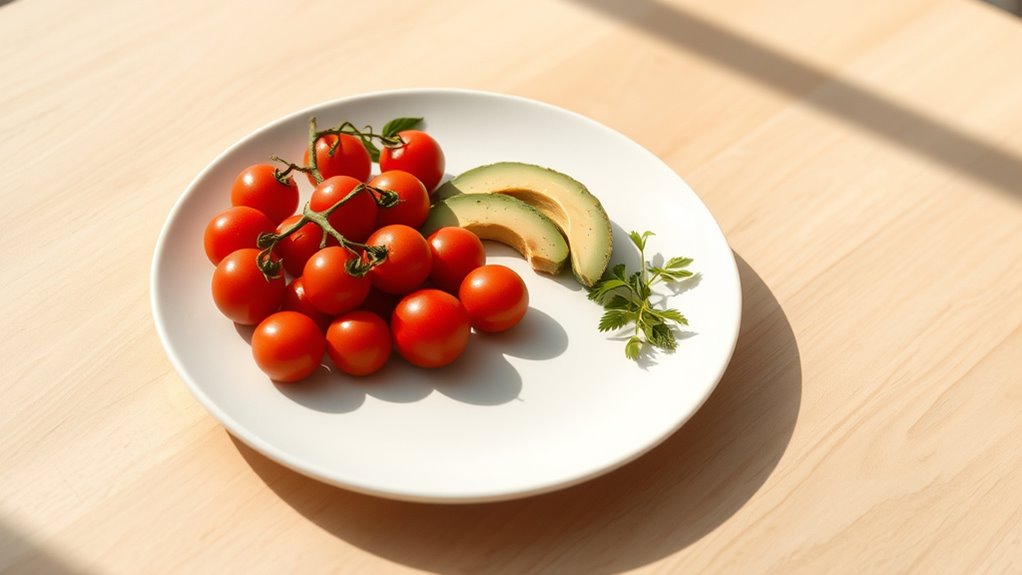Minimalist meal planning helps you focus on a few versatile ingredients like rice, eggs, beans, and seasonal vegetables, making meals simpler and more nutritious. By preparing batch-cooked grains and chopped veggies, you save time and reduce decision fatigue, while minimizing food waste. This approach streamlines grocery shopping and encourages healthier choices without sacrificing flavor or variety. Stick with it, and you’ll discover how fewer ingredients can lead to better, more nourishing meals effortlessly.
Key Takeaways
- Focus on versatile core ingredients like rice, eggs, and vegetables to create nutritious, simple meals with minimal shopping and prep.
- Batch-cook grains and proteins to streamline meal assembly, saving time and reducing reliance on processed foods.
- Reduce ingredient variety to enhance nutrient density and ensure balanced meals without unnecessary complexity.
- Plan meals around seasonal, whole foods to maximize flavor, nutrients, and cost-effectiveness with fewer ingredients.
- Simplify grocery shopping by sticking to a concise list of essential items, lowering impulse buys and food waste.

Minimalist meal planning simplifies your weekly routine by focusing on just a few versatile ingredients and straightforward recipes. When you keep your ingredient list small, you spend less time figuring out what to cook and more time enjoying your meals. This approach streamlines meal prep, allowing you to cook in larger batches and store leftovers for busy days. With fewer ingredients, grocery shopping becomes faster and less stressful—you can stick to a concise list, avoiding unnecessary purchases and reducing waste. Plus, shopping for fewer items means shorter trips and a more efficient experience, freeing up your time for other priorities.
Simplify your week with fewer ingredients and faster, less stressful grocery shopping.
By choosing versatile ingredients like rice, eggs, beans, and seasonal vegetables, you can mix and match meals easily throughout the week. These staples serve as the foundation for breakfast, lunch, and dinner, offering variety without overcomplicating your grocery list. For example, cooked rice can become a stir-fry, a grain bowl, or a simple side dish. Eggs can be scrambled, boiled, or used in frittatas, giving you flexibility while keeping prep work minimal. Beans add protein and fiber, making your meals more filling and nutritious, while seasonal vegetables add flavor and nutrients without breaking the bank. This focus on multipurpose ingredients keeps your meals interesting without requiring a long list of specialized products.
Meal prep becomes more manageable when you’re working with fewer ingredients. You can dedicate a couple of hours on the weekend to batch-cook grains, chop vegetables, and prepare proteins. These prepped components can be assembled quickly throughout the week, saving you from last-minute cooking or reliance on takeout. By having ready-to-use ingredients, you reduce daily decision fatigue and eliminate the temptation to grab less nutritious options. Incorporating hydrogen fuel cells into your meal planning approach can inspire innovative ways to optimize energy and efficiency in your routines. This method also encourages healthier eating habits because you’re in control of what goes into each dish, ensuring balanced nutrition with minimal effort.
Grocery shopping, in this minimalist approach, demands a strategic plan. You’ll find that creating a simple, focused shopping list not only saves time but also helps you avoid impulse buys. Stick to your core ingredients and avoid aisles cluttered with tempting but unnecessary items. As your repertoire grows with these basic ingredients, you’ll discover new ways to combine them, keeping meals fresh and exciting. Over time, this habit reinforces smarter shopping choices, reduces food waste, and enhances your overall diet quality. Ultimately, minimalist meal planning empowers you to enjoy nourishing, delicious meals with less hassle, more consistency, and a clearer focus on what truly matters—your health and your schedule.
Frequently Asked Questions
How Can I Ensure Variety With Fewer Ingredients?
You can guarantee variety with fewer ingredients by focusing on seasonal ingredients and exploring different flavor combinations. Use fresh, in-season produce to keep meals interesting and vibrant. Mix and match herbs, spices, and condiments to create new taste profiles without adding extra items. Experiment with various cooking techniques like roasting, grilling, or sautéing to bring out different flavors. This way, your meals stay diverse and nutritious even with a simple ingredient list.
Are Minimalist Meals Suitable for All Dietary Restrictions?
You might wonder if minimalist meals suit all dietary restrictions. The good news is, they can, with some adjustments. You can include gluten-free options like rice or quinoa and swap ingredients for vegan substitutions, such as tofu or beans. By focusing on simple, versatile ingredients, you can create meals that meet various needs while keeping preparation straightforward and nutritious. This approach makes it easier to stick to your dietary goals.
What Are Some Quick Minimalist Meal Prep Tips?
They say “a stitch in time saves nine,” and that’s true for quick minimalist meal prep. To save time, plan your meals ahead and choose versatile ingredients. Use simple storage tips like airtight containers to keep everything fresh. Batch cook staples like grains or roasted veggies, so you can assemble meals quickly. This way, you’ll enjoy nutritious, minimalist dishes without the hassle, making your prep efficient and stress-free.
How Do I Balance Macros in Minimalist Meal Plans?
To balance macros in minimalist meal plans, focus on understanding your ideal macronutrient ratios for your goals. Use portion control to guarantee you’re getting the right amounts of carbs, proteins, and fats in each meal. Stick to simple, nutrient-dense ingredients that naturally align with these ratios. Planning ahead helps you stay consistent, making it easier to meet your nutritional needs without overcomplicating your meals.
Can Minimalist Meal Planning Help With Weight Loss?
You might think minimalist meal planning limits your options, but it actually helps with weight loss by simplifying portion control and calorie counting. When you focus on fewer ingredients, it’s easier to monitor what you eat, reducing overeating and unhealthy choices. This approach keeps meals straightforward, making it easier to stick to your goals. With mindful choices, minimalist meal planning can be an effective way to shed pounds and stay on track.
Conclusion
By simplifying your meals and focusing on fewer, high-quality ingredients, you’ll enjoy better nutrition without the hassle. Remember, “less is more”—and in this case, it’s true. With minimalist meal planning, you’ll save time, reduce stress, and eat healthier. Just start small, stay consistent, and trust that simple can be delicious. Before you know it, nourishing your body becomes effortless and enjoyable. So, embrace simplicity and savor the benefits of a streamlined approach!









